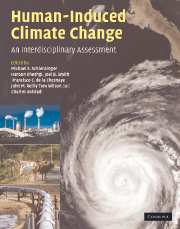Book contents
- Frontmatter
- Contents
- List of contributors
- Preface
- Part I Climate system science
- 1 The concept of climate sensitivity: history and development
- 2 Effect of black carbon on mid-troposphere and surface temperature trends
- 3 Evaluating the impacts of carbonaceous aerosols on clouds and climate
- 4 Probabilistic estimates of climate change: methods, assumptions and examples
- 5 The potential response of historical terrestrial carbon storage to changes in land use, atmospheric CO2, and climate
- 6 The albedo climate impacts of biomass and carbon plantations compared with the CO2 impact
- 7 Overshoot pathways to CO2 stabilization in a multi-gas context
- 8 Effects of air pollution control on climate: results from an integrated global system model
- Part II Impacts and adaptation
- Part III Mitigation of greenhouse gases
- Part IV Policy design and decisionmaking under uncertainty
- Index
- Plate section
- References
7 - Overshoot pathways to CO2 stabilization in a multi-gas context
from Part I - Climate system science
Published online by Cambridge University Press: 06 December 2010
- Frontmatter
- Contents
- List of contributors
- Preface
- Part I Climate system science
- 1 The concept of climate sensitivity: history and development
- 2 Effect of black carbon on mid-troposphere and surface temperature trends
- 3 Evaluating the impacts of carbonaceous aerosols on clouds and climate
- 4 Probabilistic estimates of climate change: methods, assumptions and examples
- 5 The potential response of historical terrestrial carbon storage to changes in land use, atmospheric CO2, and climate
- 6 The albedo climate impacts of biomass and carbon plantations compared with the CO2 impact
- 7 Overshoot pathways to CO2 stabilization in a multi-gas context
- 8 Effects of air pollution control on climate: results from an integrated global system model
- Part II Impacts and adaptation
- Part III Mitigation of greenhouse gases
- Part IV Policy design and decisionmaking under uncertainty
- Index
- Plate section
- References
Summary
Introduction
Stabilization of the climate system requires stabilization of greenhouse-gas concentrations. Most work to date has considered only stabilization of CO2, where there are choices regarding both the concentration stabilization target and the pathway towards that target. Here we consider the effects of accounting for non-CO2 gases (CH4 and N2O), for different CO2 targets and different pathways. As primary cases for CO2 we use the standard “WRE” pathways to stabilization at 450 ppm or 550 ppm. We also consider a new “overshoot” concentration profile for CO2 in which concentrations initially exceed and then decline towards a final stabilization level of 450 ppm, as might occur if an initial target choice were later found to be too high.
Emissions reductions for CH4 and N2O are optimized for the different pathways using an energy-economics model (MERGE). The optimization procedure minimizes the total cost of emissions reductions. The CH4 and N2O emissions reductions lead to substantially reduced future warming and future sea-level rise relative to stabilization cases where likely emissions reductions for these gases are ignored. For central climate and sea level model parameter values the reductions are 0.3–0.4 °C and 2–3 cm in 2100 and 0.9–1.0 °C and about 14 cm in 2400. Reduced CH4 and N2O emissions also allow larger CO2 emissions by reducing the magnitude of climate feedbacks on the carbon cycle.
- Type
- Chapter
- Information
- Human-Induced Climate ChangeAn Interdisciplinary Assessment, pp. 84 - 92Publisher: Cambridge University PressPrint publication year: 2007
References
- 7
- Cited by



